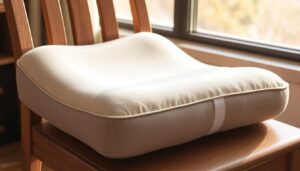After having a baby, new moms need to be careful with their bodies. The body changes a lot, so it’s important to do things safely and right.
Lifting your baby is very important. Doing it wrong can hurt your back or make things worse. So, it’s key for new moms to learn how to lift safely and well.
Key Takeaways
- Understand the physical changes during postpartum recovery.
- Learn proper lifting techniques to avoid complications.
- Prioritize new mom ergonomics for a healthy recovery.
- Be cautious with physical activities during postpartum.
- Safe lifting practices are crucial for new mothers.
Understanding Postpartum Physical Changes
Women go through big changes after having a baby. These changes make it hard to lift their baby safely. They include a separated belly, weak pelvic floor, and changes in joints and ligaments.
Abdominal Muscle Separation (Diastasis Recti)
Diastasis recti happens when the belly muscles split. This makes lifting harder. It’s common after a baby because of the strain on the belly during pregnancy. Using the right core techniques is key to avoid problems.
Pelvic Floor Weakness and Instability
The pelvic floor muscles are important for stability. But, they can get weak or damaged after a baby. Doing exercises for the pelvic floor can help make them stronger.
Hormonal Effects on Joints and Ligaments
Changes in hormones after a baby can make joints and ligaments loose. This makes it easier to get hurt when lifting. It’s important to lift gently and carefully. Here’s a table about these changes:
| Physical Change | Effect on Lifting | Mitigation Strategy |
|---|---|---|
| Diastasis Recti | Weakened core | Proper core engagement |
| Pelvic Floor Weakness | Instability | Pelvic floor exercises |
| Hormonal Effects | Increased risk of injury | Gentle lifting techniques |
Back Strain and Posture Challenges
Back pain and posture problems are common after a baby. Keeping good posture and doing back exercises can help. Knowing about these changes helps new moms lift safely.
Why Proper Lifting Technique Matters After Birth
Proper lifting is key for healing and staying safe after having a baby. A new mom’s body changes a lot. These changes can affect her muscles and bones.
Preventing Further Injury and Complications
Proper lifting is very important to avoid more harm. Avoiding heavy lifting helps stop problems like pelvic organ prolapse. This is because the muscles in the pelvis get weaker.
Supporting the Recovery Process
Right lifting helps the body heal faster. This is very important when the body is still fixing itself after having a baby.
Establishing Healthy Movement Patterns
Learning to lift right helps new moms move better. Engaging in safe lifting practices makes muscles stronger and improves posture.
Long-term Musculoskeletal Health Benefits
Good lifting habits are good for muscles and bones over time. They help avoid long-term back pain and other muscle problems.
| Benefits of Proper Lifting Techniques | Description |
|---|---|
| Injury Prevention | Reduces the risk of injury and complications during postpartum recovery. |
| Recovery Support | Supports the healing process by minimizing strain on the body. |
| Healthy Movement Patterns | Promotes good posture and strengthens muscles. |
| Long-term Health | Contributes to long-term musculoskeletal health and reduces chronic pain risk. |
Essential Preparation Before Lifting Your Baby
Getting ready to lift your baby is more than just picking them up. It’s about planning and getting ready first. This can help avoid injuries and make caring for your baby easier.
Creating Ergonomic Nursery Spaces
An ergonomic nursery makes caring for your baby easier on your body. It’s set up so you don’t have to bend or stretch too much. Make sure the changing table, crib, and other things are at easy-to-reach heights.

Positioning Necessities Within Reach
Having everything you need close by helps a lot. This means diapers, clothes, and toys should be easy to get to. This way, you won’t have to bend or stretch as much.
Wearing Supportive Clothing and Footwear
Wearing the right clothes and shoes is key for new moms. The right clothes help keep your back and belly stable. And comfy shoes make it easier to move around with your baby.
Mental Preparation and Movement Planning
Mental preparation is just as important as getting your body ready. Plan your movements and take breaks when you need to. Also, having people to help with your baby can make things easier.
| Preparation Tips | Benefits |
|---|---|
| Creating an ergonomic nursery | Reduces strain on the back and joints |
| Wearing supportive clothing and footwear | Provides stability and comfort |
| Positioning necessities within reach | Minimizes bending and stretching |
| Mental preparation and movement planning | Prevents injuries and reduces stress |
Lifting Baby Safely After Birth: Core Principles
Learning to lift your baby safely is key for new moms. It helps them care for their baby without hurting themselves. After having a baby, a mom’s body changes a lot. This can make it harder to lift and carry her baby safely.
Engaging Your Core Correctly Without Strain
It’s important to use your core muscles when lifting a baby. This means using the transverse abdominis muscle. It helps support your spine and pelvis.
To use your core right, breathe in deeply. Then, as you breathe out, pull your navel towards your spine. This helps keep your body stable and lowers back strain.
Maintaining Neutral Spine Position
Keeping your spine in a neutral position is key to avoid back strain. Don’t arch your lower back too much. Instead, keep your spine straight by slightly tucking your pelvis and relaxing your shoulders.
Using Leg Strength Instead of Back Muscles
Using your leg strength is safer and more effective than your back muscles when lifting a baby. Bend your knees and lower yourself to the baby’s level, keeping your back straight. Then, push through your heels to lift up, keeping the baby close.
Breathing Techniques During Lifting
Good breathing techniques help manage pressure inside your belly when lifting. Breathe out as you lift to help keep your core stable and reduce strain. Practice deep, controlled breathing to support your lifting.
By following these core principles, you can lower the risk of injury. This ensures a safe and healthy experience for you and your baby.
Step-by-Step Guide to Lifting Your Baby from a Crib
When you take your baby out of the crib, it’s important to do it right. This guide will help you lift your baby safely and comfortably. It’s great for both you and your baby.
Proper Crib Height Adjustments for Your Body
First, adjust the crib to a height that lets you stand straight. Your hands should be on the mattress. This keeps your back safe. Think about ergonomics for new moms when setting the height.
Correct Standing Position and Alignment
Stand in front of the crib with your feet apart. This makes you stable. Bend your knees a bit to keep your back safe.
Safe Lifting Motion Sequence
To lift your baby safely, start by gently reaching into the crib. Support their head and neck. Then, lift them towards you, using your legs for help. Don’t twist or turn to avoid back strain.
Supporting Baby’s Head and Neck Properly
Always support your baby’s head and neck when lifting. This keeps them safe and comfortable. It’s especially important when lifting them from the crib.
By following these steps and paying attention to your posture, you can lift your baby safely. This way, you can enjoy a safe and loving time with your baby.
Techniques for Lifting Your Baby from the Floor
To lift your baby safely, use methods that avoid back and pelvic floor injury. This is key during the postpartum period when your body is healing. The right lifting techniques can prevent strain and injury, helping your recovery.

The Modified Squat Method for Early Recovery
The modified squat is a good way to lift your baby, especially early on. It involves squatting down to pick up your baby while keeping your back straight. Use your leg muscles to lift.
To do a modified squat, stand over your baby with your feet shoulder-width apart. Slowly lower yourself down, keeping your back straight and core engaged. Once in a squatting position, gently pick up your baby and push back up to standing with your leg muscles.
The Half-Kneeling Approach for Stability
The half-kneeling approach is another good method for lifting your baby. Start by getting down on one knee with the other foot in front. This helps distribute your weight and reduces back strain.
From this position, carefully pick up your baby. Then, push yourself up to standing using the leg that’s kneeling.
Transitioning to Standing Position Safely
When lifting your baby, it’s important to transition to standing safely. Use your leg muscles to help you stand up. Avoid pushing yourself up with your back or twisting, as this can cause strain.
Adapting Techniques for Different Recovery Stages
As you recover, you may need to adapt your lifting techniques. Early on, focus on methods that don’t strain your back and pelvic floor. As you get stronger, you can move to more dynamic movements.
Always listen to your body and adjust your techniques based on your comfort and pain levels.
Safe Methods for Transferring Baby Between Surfaces
New moms often move their baby a lot. It’s key to learn how to do it safely. This helps avoid hurting mom or baby. We’ll look at safe ways to move a baby between places.
Crib to Changing Table Transfers
When moving a baby from crib to changing table, lift safely. Keep your back straight and use your leg muscles to lift. Make sure the changing table is close to avoid stretching too much. Always lower the crib sides before lifting the baby.
Car Seat to Stroller Transitions
When moving a baby from car seat to stroller, be careful. Support the baby’s head and neck while lifting. Try to place the stroller near the car door to carry the baby less far.
Bed to Shoulder Movements
When picking up a baby from bed, lift gently. Use a gentle lifting motion and hold them securely. Make sure you have good balance and think about using a pillow for support.
Bath Time Lifting Considerations
Bath time needs extra care. Lift the baby carefully from the bath, supporting their head and body. Have a towel ready to wrap the baby in to prevent slipping.
By using these safe transfer tips, new moms can lower the risk of injury during the postpartum period.
Adapting Lifting Techniques for C-Section Recovery
For new moms with a C-section, changing how you lift is key. It helps protect the cut and aids in healing. Being careful with lifting your baby is important for your health.
Special Considerations for Incision Protection
Keeping the cut safe is very important early on. When lifting your baby, don’t put too much pressure on your belly. Use a soft lifting method and keep your back straight to lessen pain and help healing. “Being gentle with your body during the postpartum period is crucial for a smooth recovery,” Dr. [Last Name] says (
Source: [Reference]
).
Modified Movements for the First Six Weeks
In the first six weeks, move carefully to avoid hurting your belly. Lift your baby slowly and smoothly. Use your core softly and your leg muscles to help lift.
Using Support Pillows and Aids
Support pillows are very helpful during recovery. They can ease the pressure on your cut when lifting. Also, having someone help you lift can be a big help.
Gradual Progression Timeline for Healing
Healing after a C-section needs a slow and steady plan. As you get better, you can do more and lift differently. Always listen to your body and don’t rush. Talking to your doctor can help you know when to start doing more.
Common Lifting Mistakes to Avoid During Postpartum
New moms often struggle when lifting their babies after birth. Knowing common mistakes can help avoid injuries. It’s important to lift safely to heal and recover well.
Twisting While Holding Baby
Twisting while holding the baby can hurt your back and pelvic floor. Avoid turning or twisting when lifting or holding your baby. Move your feet instead to change direction, keeping your body stable.

Bending from the Waist Instead of Knees
Bending from the waist can hurt your back. Proper lifting technique involves bending at the knees, keeping your back straight, and using leg muscles to lift. This way, you avoid back and pelvic floor injuries.
Holding Baby Too Far From Body Center
Holding the baby too far from your body can strain your back and shoulders. Keep your baby close to your body when lifting or carrying. This helps you stay balanced and avoids back strain.
Rushing Through Movements When Tired
Rushing when tired can lead to accidents and injuries. Take your time and move slowly when lifting your baby. If tired, ask for help or take breaks to rest.
Knowing these common lifting mistakes and avoiding them can lower injury risks for new moms. Safe lifting practices help with physical recovery and overall well-being.
Ergonomic Baby-Wearing Options for Postpartum Bodies
After having a baby, moms can really benefit from ergonomic carriers. These carriers give good back support and spread out the baby’s weight. Baby-wearing lets moms hold their baby close and still do other things.
Front Carriers with Proper Lumbar Support
Front carriers with lumbar support are great for new moms. They spread out the baby’s weight, easing back strain. Look for carriers with adjustable waistbands and padded back support for a comfy fit.
Wraps and Slings for Different Recovery Stages
Wraps and slings are good for all stages of postpartum recovery. They adjust easily and can be worn in different ways. This lets moms find a comfortable position.
Weight Distribution Principles
It’s key to spread out the baby’s weight when wearing them. The carrier should put the weight on the mom’s body, not just her back and shoulders. A well-designed carrier can make a big difference in comfort and support.
Safe Putting On and Taking Off Techniques
It’s important to put on and take off a baby carrier safely. Practice makes perfect; take time to learn the right way. This helps avoid discomfort or injury.
| Carrier Type | Lumbar Support | Weight Distribution |
|---|---|---|
| Front Carrier | Excellent | Evenly distributed |
| Wrap/Sling | Adjustable | Customizable |
Choosing the right ergonomic baby-wearing option helps new moms. They can be close to their baby and stay comfortable. This also supports their recovery after having a baby.
Warning Signs of Improper Lifting Technique
It’s key for new moms to know the signs of bad lifting. The body changes a lot after having a baby. Bad lifting can make these changes worse.
Recognizing Pain vs. Normal Discomfort
It’s important to tell normal discomfort from real pain. Sharp or severe pain is a big warning sign. It means you need to pay attention.
- Sharp pain in the back or pelvic area
- Persistent pain that doesn’t improve with rest
- Pain that radiates down the legs or arms
Symptoms of Pelvic Floor Strain
Pelvic floor strain is common after having a baby. Look out for these signs:
- Urinary incontinence
- Pain or discomfort in the pelvic region
- A feeling of heaviness or pressure in the pelvis
Back Pain Patterns to Monitor
Back pain can show if you’re lifting wrong. Watch for these patterns:
- Pain that worsens with activity
- Pain that improves with rest
- Pain that radiates to other areas of the body
When to Consult a Healthcare Provider
If you see any of these signs, see a doctor. They can help figure out what’s wrong. They’ll also tell you how to lift safely.
Knowing these signs and acting fast can help you recover better. It’s good for your health and well-being.
Partner Involvement in Safe Baby Handling
Having a partner involved in baby care is very important. It helps the mom recover and makes the family bond stronger. Together, they can share the baby’s care, easing the mom’s workload.
Teaching Proper Techniques to Partners and Caregivers
It’s crucial to teach partners and caregivers how to handle the baby safely. Show them how to lift, change diapers, and carry the baby without hurting themselves or the baby. Proper lifting techniques are key to keeping everyone safe.

Coordinating Handoffs Between Parents
Coordinating handoffs between parents is very important. They need to talk about the baby’s needs and plan handoffs carefully. This way, they can make sure the baby is safe and comfortable.
Creating a Supportive Team Approach
A supportive team is essential for new moms. Partners can help with emotional support, household chores, and baby care. This teamwork helps the mom recover and strengthens the family bond.
Communicating Your Physical Limitations
Talking about physical limits is important. It helps partners and caregivers know what the mom can and can’t do. This way, the mom gets the support she needs and avoids overdoing it.
Strengthening Exercises to Support Safe Lifting
New moms face many challenges after having a baby. Doing strengthening exercises helps them lift their babies safely. These exercises make the core, pelvic floor, and upper body stronger. This is key for lifting safely.
Gentle Postpartum Core Rehabilitation
It’s important to start gentle core exercises after having a baby. Doing pelvic tilts, gentle crunches, and leg raises helps. These exercises make the core muscles stronger without hurting the body too much.
Pelvic Floor Exercises for Stability
Kegels, or pelvic floor exercises, are very important. They help control the bladder and keep the pelvis stable. You do these by tightening and then relaxing the pelvic muscles.
Upper Body Strengthening for Carrying
Exercises like shoulder presses and arm curls are great for new moms. They help carry the baby safely and comfortably. This is especially important as the baby gets bigger and heavier.
Progressive Strength Building Timeline
It’s important to build strength slowly and safely. A plan that gets stronger over time is best. This plan should match the mom’s recovery and health.
| Exercise | Week 1-2 | Week 3-4 | Week 5-6 |
|---|---|---|---|
| Pelvic Tilts | 3 sets of 5 | 3 sets of 10 | 3 sets of 15 |
| Kegels | 3 sets of 5 | 3 sets of 10 | 3 sets of 15 |
| Shoulder Presses | 3 sets of 5 | 3 sets of 10 | 3 sets of 15 |
Adjusting Techniques as Your Baby Grows
It’s important to change how you lift your baby as they grow. This keeps you healthy and avoids strain. As your baby gets bigger and moves more, you need to lift differently.
Modifications for Increasing Weight
When your baby gets heavier, you should get stronger. Do gentle exercises to make your core and legs stronger. Proper lifting techniques are key to not hurting your back.
Adapting to Baby’s Changing Mobility
Your baby will move more as they grow. They might twist and turn while you’re lifting. Staying alert and adjusting your grip helps avoid accidents.
Transitioning to Toddler Lifting Methods
When your baby turns into a toddler, lifting them is different. You need to learn safe ways to lift a bigger child. This keeps you and your back safe.
Long-term Ergonomic Considerations
Creating a safe space for you and your child is important. This means setting up ergonomic areas for feeding, playing, and sleeping. A study shows that ergonomic practices can prevent long-term back pain.
Mothers who practice ergonomic lifting techniques during postpartum have a lower risk of chronic back pain,” according to a study published in the Journal of Ergonomics.
| Lifting Technique | Baby Stage | Key Considerations |
|---|---|---|
| Core-engaged lifting | Infancy | Engage core, bend knees |
| Adjusted grip | Toddlerhood | Support larger size, stay balanced |
| Ergonomic environment | Long-term | Create safe spaces for feeding, playing, sleeping |
Conclusion
Safe lifting is key after having a baby. It helps avoid injuries and aids in healing. Knowing how the body changes after birth helps new moms lift better.
It’s important to pay attention to how you lift. This changes as the baby grows. Also, don’t hesitate to ask for help when you need it. This way, you can avoid injuries and heal faster.
Looking after a newborn is tough. But, focusing on safe lifting and recovery is crucial. With the right lifting and support, moms can have a better experience during this time.
FAQ
What are the most common physical changes during postpartum that affect lifting?
Women often get diastasis recti and weak pelvic floors after giving birth. Hormones also affect joints and ligaments, making lifting hard.
Why is proper lifting technique crucial after giving birth?
Good lifting technique is key to avoid injury and support healing. It helps create healthy movement and keeps muscles strong.
How can I prepare my nursery to make lifting my baby easier and safer?
Make your nursery ergonomic and put things within reach. Wear comfy clothes and shoes. Get ready mentally for lifting.
What are the core principles for lifting a baby safely after birth?
What are the core principles for lifting a baby safely after birth?
Use your core right, keep your spine straight, and lift with your legs. Breathe right while lifting.
How do I lift my baby from a crib safely?
Adjust the crib to a good height. Stand right, lift safely, and support your baby’s head and neck.
What techniques can I use to lift my baby from the floor?
Try the squat method or half-kneeling. These keep you straight and avoid back strain.
How can I transfer my baby between surfaces safely?
Use safe moves like crib to changing table or car seat to stroller. Always keep control and support.
Are there special considerations for lifting after a C-section?
Yes, protect your incision and use gentle moves for six weeks. Support pillows help in recovery and lifting.
What are common lifting mistakes to avoid during postpartum?
Don’t twist, bend at the waist, or hold your baby too far. Avoid rushing when tired.
What are some ergonomic baby-wearing options for postpartum bodies?
Try front carriers, wraps, and slings. They spread your baby’s weight safely and are comfy.
How can I recognize if I’m using an improper lifting technique?
Watch for pain, pelvic floor strain, and back pain. If you see these signs, talk to a healthcare provider.
How can my partner be involved in safe baby handling?
Your partner can learn lifting techniques and help with handoffs. Work together and talk about your limits.
What exercises can help support safe lifting during postpartum?
Do gentle core exercises, pelvic floor work, and strengthen your upper body. These help with safer lifting.
How should I adjust my lifting techniques as my baby grows?
Change your lifting as your baby gets heavier. Adapt to their new movements and learn to lift toddlers.
Related Posts
- Best Pregnancy Pillows for Back Pain Relief
- The Best Nursing Pillows for Posture and Comfort
- The Ultimate Guide to Pregnancy Ergonomics: How to Stay Comfortable and Supported
- How to Sit Comfortably at Work While Pregnant
- Standing Desk Tips for Work-at-Home Moms
- How to Avoid Wrist Pain While Bottle Feeding
- Affiliate Disclosure
- Best Ergonomic Baby Carriers for Moms in 2025







